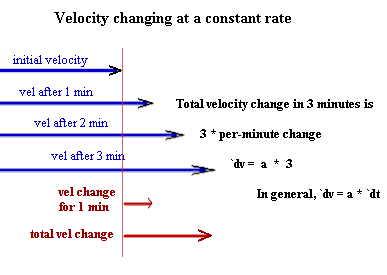Set 2 Problem number 1
Problem
Problem: If velocity increases by 9 meters per second every minute, how many minutes does it take for velocity to increase by 54 meters per second?
.
.
.
.
.
.
.
.
.
.
.
.
.
.
.
.
.
.
.
.
.
.
.
.
.
.
.
.
.
.
Solution
Solution: The velocity would go up by 9 meters per second in 1 minute, by 54 meters per second in 6 minutes.
Generalized Solution
Generalized Response: If we let a stand for the number of meters per second the velocity increases in a minute, and `dt the number of minutes, then the velocity increase in `dt minutes will be the product a `dt of the velocity increase per minute and the number of minutes. If we represent velocity increase by `dv, we have `dv = a `dt. We understand a as the rate at which velocity increases. We call a the acceleration of the object.
.
.
.
.
.
.
.
.
.
.
Explanation in terms of Figure(s), Extension
Figure description:
The figure below uses arrows to represent four different velocities, each greater than the one before it, and each corresponding to a time 1 minute later than the one before it. Longer arrows represent greater velocities.
You can see that the velocities increase by the same amount during each minute. The short red arrow represents the velocity change during the first minute. The long red arrow represents the total velocity change during the three minutes represented by the picture. Since the velocity change is the same for every minute, the total velocity change is 3 times as great as the per-minute change.
If a represents the velocity change per minute, then the total 3-minute velocity change `dv is
`dv = 3 * a.
.
.
.
.
.
.
.
.
.
.
